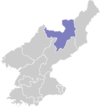Kim Jong Suk County
Kim Jong Suk County
김정숙군 | |
|---|---|
| Korean transcription(s) | |
| • Chosŏn'gŭl | 김정숙군 |
| • Hanja | 金貞淑郡 |
| • McCune-Reischauer | Kimjŏngsuk-kun |
| • Revised Romanization | Gimjeongsuk-gun |
 Map of Ryanggang showing the location of Kimjongsuk | |
| Country | North Korea |
| Province | Ryanggang |
| Administrative divisions | 1 ŭp, 2 workers' districts, 22 ri |
| Area | |
| • Total | 1,228 km2 (474 sq mi) |
| Population (2008[1]) | |
| • Total | 42,618 |
| • Density | 35/km2 (90/sq mi) |

Kim Jong Suk County is a kun, or county, in Ryanggang province, North Korea, along the Yalu River.
The Sinpa Revolutionary Site there is associated with Kim Jong Suk's underground political activities there during the anti-Japanese struggle.[2]
History
[edit]Originally part of Samsu, the county was made into a separate entity in 1952, using Samso myeon, Samsu myon, Chaso myon, and Insan ri of Hoin myon. The county was initially known as Sinpa, meaning "New Galpa", adding the new in the name to differentiate from the Old town of Galpa. The Old town name of Galpa meant the town had plenty of Kudzu vines, known as "Gal(葛)" in Hanja. Other theories suggest the name Singalpa is named after a person who made military contributions to the fight against foreign enemies.[3] The county was renamed in 1981 after Kim Jong Suk, the mother of Kim Jong Il.
Geography
[edit]Kimjŏngsuk lies in the northern portion of the Kaema Plateau, and slopes downward toward the north. The Changjin River flows through the county, which is traversed by the Puksubaek Mountains and Huisaekbong Mountains. The highest point is Huisaekbong itself, 2185 m. Some 92% of the county's area is forestland. The chief rivers are the Yalu and the Changjin. The climate varies, with extremely cold temperatures prevailing in the south, and 3-3.5 °C warmer temperatures along the Yalu in the north.
Administrative divisions
[edit]Kimjŏngsuk county is divided into 1 ŭp (town), 2 rodongjagu (workers' districts) and 22 ri (villages):
|
|
Economy
[edit]The chief local industry is logging; there is little agriculture, except for some rice cultivation along the Yalu. A certain amount of wheat, maize, soybeans, and potatoes are also produced. There are local deposits of molybdenum, gold, copper, silver, lead, zinc and tungsten. Honeybees and other livestock are also raised. Hydropower is abundant. Food processing dominates local manufacturing.
Transportation
[edit]The county is served by both road and rail, with the Pukbunaeryuk Line of the Korean State Railway passing through the county.
See also
[edit]References
[edit]- ^ North Korea: Administrative Division
- ^ "Sinpha Revolutionary Site". KCNA. 10 October 2014. Archived from the original on 13 October 2014.
- ^ "신파군".
External links
[edit]- In Korean language online encyclopedias:

